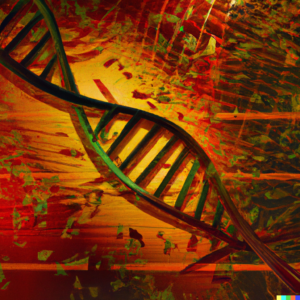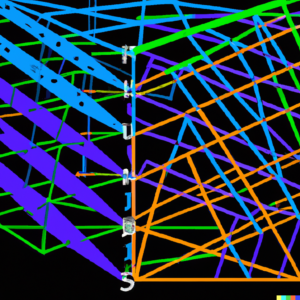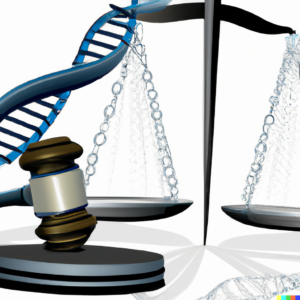Introduction: When Biology Marries Tech
In an era defined by rapid technological progress, few fields embody the transformative intersection of science and technology as eloquently as bioinformatics. As the digital and biological worlds continue to intertwine, the application of information technology in the study of biological systems has brought us to the brink of unprecedented scientific breakthroughs.
Bioinformatics is a truly multidisciplinary field, marrying the complexity of biology with the precision of computer science and information technology. It represents a critical attempt to make sense of the vast amounts of biological data generated by techniques such as genomic sequencing and high-throughput screening. Through leveraging computational tools and algorithms, bioinformatics seeks to analyze this data, transforming it into valuable biological insights.
The advent of bioinformatics has breathed life into the concept of precision medicine, heralding an era of bespoke therapeutic interventions, and it’s increasingly becoming the linchpin of contemporary biological and biomedical research. This journey will take us through the data deluge in biology, the indispensable role of machine learning and powerful algorithms, real-world breakthroughs, and the ethical considerations that come with these advancements.
In the following sections, we’ll delve deeper into the riveting world of bioinformatics, traversing the nuances of this field that sits at the exciting crossroads of biology and information technology. Buckle up for a thrilling journey into the digital heart of biology!
Navigating the Biological Data Tsunami
Welcome to the age of big data in biology, where modern experimental techniques generate an overwhelming amount of information every single day. It’s a world that revolves around genomics and proteomics and extends even further to metabolomics, transcriptomics, and other ‘omics. Each ‘-omics’ branch focuses on a specific aspect of biology at a large-scale, high-throughput level, resulting in vast amounts of data that require special methods for analysis and interpretation.
Genomics, for example, is all about understanding the complete set of DNA within an organism – its genome. Over the past few decades, technologies like next-generation sequencing have enabled us to sequence genomes at a pace that was unthinkable in the era of the Human Genome Project. Today, sequencing the human genome is not only faster, but it’s also more affordable, allowing scientists to gather enormous amounts of genomic data.
Then, we have proteomics – the large-scale study of proteins, the vital workers in every cell. Mass spectrometry-based proteomics, as well as other advanced techniques, allow researchers to identify and quantify thousands of proteins in a single experiment, providing vital insights into cellular function and disease mechanisms.
But, the ‘omics don’t stop there. Metabolomics studies the complete set of small-molecule metabolites within a biological system, giving us a snapshot of cellular physiology. Meanwhile, transcriptomics is the study of the full set of RNA transcripts produced by the genome, shedding light on gene expression.
This massive, ever-growing pool of biological data represents both an extraordinary resource and a remarkable challenge. How can we efficiently process and extract meaningful insights from this sea of data? This is where the computational power of bioinformatics comes into play, providing the tools necessary to navigate the data deluge in biology.
Machine Learning: The Engine Driving Bioinformatics
Machine Learning (ML), a subset of Artificial Intelligence (AI), has risen to become the brainpower that drives bioinformatics. By developing algorithms and statistical models that improve through experience, ML allows us to make sense of the vast amounts of biological data generated by ‘omics’ technologies.
You see, the complex patterns and relationships in biological data can be extremely difficult to decipher using traditional statistical methods. Enter ML, with its ability to learn from and make decisions or predictions based on data. In the world of bioinformatics, machine learning methods have been critical in the development of predictive models that are robust and scalable, enabling data analysis on an unprecedented scale.
From clustering gene expression data to classifying protein structures, ML methods like decision trees, support vector machines, and neural networks have been applied with remarkable success. In genomics, ML can assist in tasks such as predicting gene function based on sequence data or identifying disease-associated genetic variants. Similarly, in proteomics, ML can help predict protein-protein interactions and classify proteins based on their functions.
Deep learning, a more complex form of machine learning inspired by the human brain’s network of neurons, is also being utilized in bioinformatics. By utilizing deep neural networks, we can predict and classify biological data with even greater accuracy, potentially unlocking new insights about diseases and biological processes.
But, like any powerful tool, machine learning in bioinformatics is not without its challenges. The risk of overfitting models to data, the interpretability of complex ML models, and the need for robust validation methods are just a few of the considerations when employing ML. However, as we continue to refine these technologies and methodologies, ML’s role as the driving force in bioinformatics will undoubtedly grow even stronger.
Unleashing the Power of Algorithms: Beyond Traditional Biology
A cornerstone of bioinformatics, algorithms have played a monumental role in the way we analyze and interpret biological data. From aligning genetic sequences to determining the evolutionary relationships between species, algorithms are the silent workhorses of bioinformatics, capable of performing complex analyses that are far beyond human capability.
Consider sequence alignment, a fundamental task in bioinformatics that involves comparing and aligning sequences of DNA, RNA, or proteins to identify regions of similarity. Alignment algorithms, such as the Needleman-Wunsch and Smith-Waterman algorithms for global and local alignment, respectively, are vital in tasks ranging from determining evolutionary relationships to predicting protein structures.
Phylogenetic analysis, the study of evolutionary relationships among groups of organisms, is another area in bioinformatics that relies heavily on algorithms. For example, the Neighbor-Joining algorithm constructs phylogenetic trees by grouping organisms based on genetic distance, thereby offering valuable insights into evolutionary history.
Then there’s the application of algorithms in genome assembly and annotation. Algorithms like De Bruijn graphs have been integral to assembling the vast amounts of short-read sequencing data generated by next-generation sequencing technologies. Once a genome is assembled, algorithms aid in genome annotation by identifying and demarcating the locations of genes and other genomic elements.
From predicting the 3D structure of proteins (like the Rosetta algorithm) to mining biological databases and even simulating biological systems, the power of algorithms in bioinformatics is widespread and profound. Each algorithm, optimized for a specific task, has the potential to reveal new dimensions of our understanding of life at a molecular level. As the field of bioinformatics evolves and the data continues to grow, the development and application of efficient algorithms will remain a critical area of research.
Unlocking Biological Mysteries: Real-world Bioinformatics Breakthroughs
Bioinformatics has profoundly shaped the field of biology, paving the way for groundbreaking discoveries and applications that have real-world impacts. The fusion of biology and information technology has catalyzed breakthroughs across various domains from personalized medicine to evolutionary biology.
Consider precision medicine, for instance. The ability to sequence an individual’s entire genome rapidly and affordably has revolutionized our approach to treating diseases. Bioinformatics tools allow us to sift through these vast amounts of genetic data to identify disease-linked genetic variants. This capability opens the door to personalized treatment strategies tailored to an individual’s genetic makeup, optimizing therapeutic efficacy while minimizing potential side effects.
In drug discovery, bioinformatics has been instrumental in expediting the drug development pipeline. Computational tools can predict the 3D structure of target proteins, simulate the docking of potential drug molecules, and evaluate their binding affinity. This in silico screening substantially reduces the time and cost of drug discovery, accelerating the path to market for lifesaving treatments.
Moreover, bioinformatics has been central to advancements in agriculture. Through genome sequencing and the application of bioinformatics tools, scientists can identify crop varieties with desirable traits, like drought resistance or pest resistance. These insights are invaluable in our quest to enhance agricultural productivity and sustainability in the face of climate change.
In the domain of evolutionary biology, bioinformatics tools facilitate the construction of detailed phylogenetic trees, providing insights into the evolutionary relationships among different species. By comparing genomes across different organisms, scientists can track the footprints of evolution, providing a deeper understanding of the complexity of life.
These examples merely scratch the surface of bioinformatics’ influence. As our technological capabilities continue to advance, the role of bioinformatics in driving breakthroughs in biology and medicine will only become more pivotal. Bioinformatics, by unearthing the wealth of information hidden within biological data, is not just accelerating scientific discovery but reshaping our world in the process.
Navigating the Ethical Minefield in Bioinformatics
While the advancements in bioinformatics have been monumental in accelerating scientific progress, they also raise significant ethical questions that cannot be ignored. As we navigate through the intersection of biology and information technology, we must grapple with complex issues surrounding privacy, consent, data security, and equity.
One of the most prominent ethical concerns in bioinformatics is the privacy of genetic data. As more individuals have their genomes sequenced and contribute their data for research, there’s an increased risk of privacy breaches. Although these sequences are often de-identified, sophisticated computational tools could potentially re-identify individuals. This could lead to genetic discrimination or misuse of the data, making it crucial to establish stringent data protection measures and policies.
Additionally, informed consent is a significant issue when it comes to genetic testing and data sharing. Individuals need to understand the implications of contributing their genetic data for research, including potential secondary uses of the data. As science and technology advance, the very notion of what constitutes informed consent will need to adapt and evolve.
Data security is another key concern. As massive volumes of biological data are stored and shared digitally, the risk of cyberattacks increases. Protecting these databases from breaches requires sophisticated security measures and an ongoing commitment to data protection.
Finally, we must consider issues of equity. The benefits of bioinformatics – from personalized medicine to improved crop varieties – should be accessible to all, not just those who can afford it. Furthermore, the genetic databases used for research should reflect the diversity of the global population to ensure that discoveries and treatments are effective across different ethnic groups.
Navigating these ethical complexities is no simple task. It requires ongoing dialogue among scientists, ethicists, policy-makers, and the public. Through this collaborative approach, we can harness the power of bioinformatics to drive scientific progress while upholding our commitment to ethical principles.
Conclusion: Steering the Future of Bioinformatics Amidst Challenges
As we move forward into an era where data-driven biology is becoming the norm, the importance of bioinformatics cannot be overstated. With its capacity to handle enormous amounts of data and extract meaningful insights, bioinformatics is at the forefront of scientific innovation. Yet, as we have explored, its rise is not without challenges.
As the pace of data generation continues to accelerate, the need for advanced data management and analysis techniques will only grow. Bioinformatics will have to evolve in tandem with these needs, striving for new algorithms, systems, and methodologies to make sense of the vast biological data landscape. Furthermore, the ever-increasing computational demands of bioinformatics call for continued development of high-performance computing infrastructure.
Yet, beyond these technical challenges, bioinformatics must also grapple with ethical and social issues. Privacy, consent, data security, and equity are all paramount concerns that will need to be addressed. The discussions around these issues must be collaborative, involving not just scientists but ethicists, policymakers, and the public.
The future of bioinformatics is undoubtedly bright, filled with exciting opportunities and potential breakthroughs. However, it is a future that must be navigated with care, balancing the pursuit of scientific progress with ethical responsibilities. With a thoughtful and proactive approach, we can harness the power of bioinformatics to unlock new frontiers in biology and medicine.





